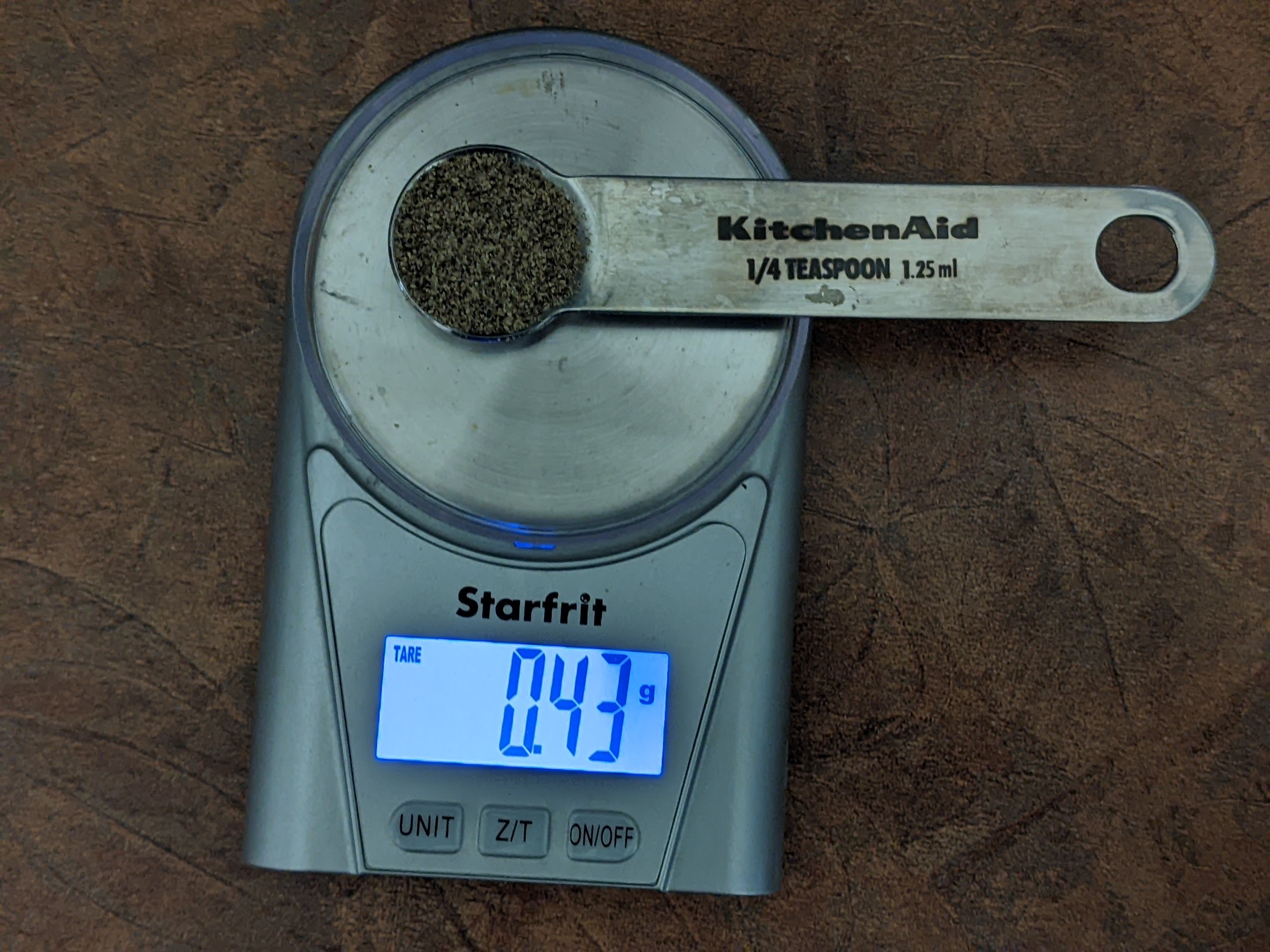I’m tired of guessing which country the author is from when they use cup measurement and how densely they put flour in it.
i cant imagine this would be unpopular for anyone who actually bakes.
its so frustrating not having exact amounts for what is essentially chemistry.
I wanted to believe my opinion is popular yet recipes I’ve seen are almost in volume and I don’t know why.
Baking is chemistry for sure.
My total guess is weighing scales used to be expensive / inaccessible for the common home baker and one of the first popular recipe books thus used volume, became wildly popular, and indirectly taught a generation of home bakers that baking recipes are by volume, not weight.
In my opinion every recipe should be in weight unless there’s a good reason to put it in volume. The idea of washing half a dozen individual little measuring cups to prepare one recipe is absurd. Slap a bowl on your scale and go to town.
You mean a separate bowl from the main container, right? So you can remove over-scoops without disturbing the previous ingredients? I’m still trying to get comfortable with my scale. I get frustrated because there’s not parts of grams, and it doesn’t seem to constantly update, it just jumps from too little to too much.
Always 2nd bowl. Having a more sensitive scale helps with it updating faster. You can also tap the scale to try and get it to update.
I use a 0.1g/2kg scale for most things, I also have a 1g/5kg one I never use. I can’t find it rn but I also have a 0.01g/100g scale for when smartasses on the internet tell me to weigh a 1/8 tsp of pepper.
What does 1/8 tsp of pepper weigh?
Here you go. It weighs about 0.21g

That’s a small pinch of pepper. I don’t even own a measure that size.
I have a 1/8 teaspoon but the idea is… why? Anything being pinched, I’m not digging out a measuring spoon for.
Measuring by volume is definitely ridiculous. I’m an USAmerican baker.
I feel like this is just a remnant of a time where a container with a bunch of lines on it was cheaper than a sufficiently accurate scale. It might just go away over 1-2 more generations.
Anyone who gets into baking today will quickly learn volumetric measuring doesn’t work.
Basic baking you can get away with volumetric (simple breads, for example). Anything beyond that… Well, good luck.
Scales have been cheap for a couple generations now. Digital scales didn’t exist until I was an adult, but the cheap spring type did. And those were maybe $5 decades ago. It’s more about awareness and knowledge. Cookbooks 50 years ago wouldn’t have had weight measurements because people didn’t have scales.
While it’s chemistry, there is a bit of an art to it, and you can be off by a bit and still have perfectly good bread.
I can’t get my octogenarian mother to bake by weight, but she’s certainly not on Lemmy.
Black magic chemistry at that, since local, varying conditions can affect baking so much.
It really doesn’t matter that much. When was the last time you had your kitchen scale calibrated? Are you actually putting in exactly 200g of flour? Or are you calling it good at anything between 190-210? I was a chemistry minor in college and no one was meticulously measuring out the eaxct amount or reagents they needed, they got it to the ball park and made sure to record exactly how much they used. You’re a home cook making a treat for your friends and family, not the royal pastry chef. And guess what? Those royal pastry chefs in the 18th century were also doing recipes by volume since precision scales weren’t readily available. Meanwhile i get frustrated when i run into a recipe that only uses weights because I’m not used to it. I already have incredibly limited counterspace, and find somewhere to set up my kitchen scale immediately throws me off my game.
As someone said elsewhere in this thread, you aren’t upset at volumetric measurements, you’re upset at American cultural hegemony.
bad practices become bad policies. minor issues scale terribly. its not crazy to want to do things appropriately.
as others have pointed out, scaling is far easier than washing handfuls of measuring devices. i can easily counter with your process sucks and takes more work just because you lack counterspace as opposed to dishwashing space.
just because you dont want to be exact doesnt mean others cant or shouldnt.
I’m getting high as fuck and baking treats for my friends and coworkers, not making something for a competition or dignitary. The process is irrelevant, what i was saying is that whatever you are comfortable with you should use. I can quickly scoop out 3 cups of flour and a cup and a half of sugar in the same time you can weigh them out. And at the end of the day no one will be able to tell the difference between our cookies. The temperature and humidity of your kitchen is going to have way more of an impact on your final product than a 2-5% variation in the quantity of ingredients.
If you are wondering why your cookies come out different every time you bake, it isn’t due to variance of temperature and humidity – IT IS BECAUSE YOU ARE USING WILDLY DIFFERENT AMOUNTS OF FLOUR.
And yes you ducking can tell the difference between a batch of cookies where the flour is weighed vs scooped.
You can’t accurately measure flour by volume. The amount you get in a scoop will vary depending on how compressed it is. You weigh flour to remove that variance, which can be far greater than 5%. Don’t believe me? Put a cup of flour in a measuring cup, then start pressing on it to pack it (you won’t have anywhere near a cup anymore). Controlling for flour density (ie: consistently measure by volume) is nearly impossible.
Brown sugar is similar but easier to manage (most recipes tell you to use packed measures instead of scooping).
Things like white sugar, sure – scoop away.
when I was a chemistry minor we did things the wrong way
No wonder your opinion is wrong
Please tell me about how your universities ran their chemistry labs then, because that’s how they were at every college i attended.
I have a chemistry B.S. and Ph.D. Some reactions don’t need to go to completion or are not expected to, like organic syntheses. In other cases it’s important to get the ratio of the reactants correct, otherwise you get precursor mixed in with your product. For baking you don’t want leftover baking soda, or flour, etc.
You’re a home cook making a treat for your friends and family
And with those methods, you’ll never amount to anything more. Why improve your craft when you can be an underachiever, right?
Especially such an easy win as weighing out ingredients? It takes even less effort than counting the spoonfuls or having to sift flour into a measuring cup to prevent compacting and ruining the volumetric measurement.
Use non-American recipes.
The rest of the world does this. And guess what, 1 milliliter of water is exactly 1 gram, unlike stupid ounces.
If I want a recipe in English I always end the search query with “UK” to make sure it’s in weight, not cups. I’m not a fucking toddler
I try that too for English recipes but then I get things in tablespoons, teaspoons, pinches, good pinches, full pinches, and small bunches.
Or my favorite “a good knob of butter”
At least they aren’t using stone for flour though lol.
a millilitre of water is a gram, dog
Geez, you and the other commenter have good timing. It was a temporary edit to mess with an active commenter. Started as gram 😉
Density differs for other ingredients though.
It does, but I would still rather use grams usually. My ice cream base recipe says 500g skim milk and 470g heavy cream. I don’t have to get a measuring cup dirty—I just pour them into the bowl.
Wait, why on earth would you use skim milk in ice cream when you’re adding in basically equal parts cream anyway?
The only thing that really matters is the average milk fat %. I like Costco’s 40% heavy cream from a price and quality standpoint. My family drinks skim milk. If I mix those two equally I will end up with about 20% fat which makes a very nice ice cream.
Yeah I guess if you already have skim milk around the house then that makes sense.
1 mL water is 1 gram
Hah, that was a temporary edit to mess with the other commenter 😉 Good timing for you I guess.
one fluid ounce of water is one (weight) ounce of water
Not exactly true. See other comments.
A fluid ounce of water is an ounce of weight
Except that’s not true.
An imperial fluid ounce is 1⁄20 of an imperial pint, 1⁄160 of an imperial gallon or exactly 28.4130625 mL.
A US customary fluid ounce is 1⁄16 of a US liquid pint and 1⁄128 of a US liquid gallon or exactly 29.5735295625 mL, making it about 4.08% larger than the imperial fluid ounce.
A US food labeling fluid ounce is exactly 30 mL.
So we have 28.4g, 29.6g or 30g of water. An ounce is 28.3g (closest to the imperial measures and neither of the US ones, despite the ounce being common to imperial and US systems)
I’d consider that within the margin of error for a volumetric measurement. Especially if you are being lazy like me and measuring something like milk by weight.
Funny enough, you made me go check my kitchen scales. They report in grams, ounces, and weirdly milliliters and fluid ounces. I used my scale that reports in hundredths of a gram to measure out exactly 1 oz mass. I then placed it on my other three scales to see what it would read. 2 of them correctly reported that they weren’t quite at 1 fluid ounce, while the other said it was. I never actually put my scales in ounce mode, though.
Just because no one in your life cares enough about your niche opinion to actually have an opinion does not make that an “unpopular opinion.” When your opinion is the opinion of hobbyists, professionals, and elites alike, it’s certain not unpopular, even if it is niche.
You’re certainly right in your opinion, and that’s the point of bitching at you.
OP is probably from Western Europe, where a kitchen scale is common. Ain’t nobody in the US got a fancy kitchen scale.
The solution to their problem is use mL for volume.
Ain’t nobody in the US got a fancy kitchen scale.
Lots of us have them. (Well, basic scales which weigh a tenth of a gram.) They’re useful when weighing compressible dry ingredients like flour and brown sugar, and viscous wet ingredients like molasses and corn syrup. They’re also helpful when you’re multiplying a recipe by a factor that doesn’t result in useful units; it’s annoying to figure out how to measure out fractional cups that involve teaspoons.
They also help with portion control if you’re watching calories.
I have had two different well-recommended scales for baking and neither does a good job measuring 1-3 grams of ingredients. Maybe I just need to spend hundreds of dollars I don’t have on some pampered chef thing….
I do have what we call the “drug scale” in our house. It can measure to 0.01g but its capacity is so low it is useless for baking. I don’t want to weigh my baking soda badly enough to get it out.
“coffee scales” are good for gram scale quantities
I use this one, it’s affordable and it does a good job.
That is so cool!
I have one like that that goes up to 400g I think. I tried using it for measuring my creatine powder once but it wasn’t sensitive enough. Trying to cook with it seems like it would be a pain in the ass unless I was making huge batches of stuff.
Sounds to me like you just have a bad scale?
It can do tenths of grams. That seems pretty good to me. Just seems like it’s more trouble than it’s worth to do small amounts like that by weight anyway.
I have a pretty good scale, but it doesn’t register below 2.5g. You either need a different kind of scale for that sort of thing, or spend a lot of money on a lab-grade scale that can do both light and (relatively) heavy.
Technically oils and milk are lighter per volume than water so the mL to g conversion doesn’t really work. mL only equals g of water, specifically.
I wasn’t thinking about conversations, only picking a standard. A mL is a mL no matter where you are in the word.
deleted by creator
This isn’t unpopular.
Anyone who learns to bake quickly learns this.
If you bake regularly then this is a popular opinion. I generally won’t bother with a recipe that does not have the weights.
But then you bake REALLY regularly, and you don’t follow recipes anymore. I know exactly what the doughs and batters look like and how they pour. I know how adding sugar and water will loosen up the batter. I know exactly how the pizza flour should ocillate between the dough hook and the walls of the bowl.
It’s like this bell curve of measuring
Flour’s ability to absorb water changes depending on what variety of wheat and where it was grown and what the weather was like during the season. Weight is also just a guideline. Baking is not an exact science.
Pretty sure any pastry chef will strongly disagree with that. If anything, baking is the cooking activity most akin to an exact science. The amounts need to be carefully measured, the temperatures need to be exactly right (e.g. Italian merengue), the baking time needs to be correct to the second for some dishes (lava cake).
Yes, the measures can change based on the flour or its substitutes (ground pistachio for example), but the processes involved require an equal amount of precision.
A lot of chefs call cooking an art, but baking a science.
I am a former pastry chef and baker. You’d think it’s very precise work but it’s actually mostly intuition based on experience. You know the recipes and tweak them as you go. Also the batch sizes are many times bigger than a home cook ever makes so a cup of flour more or less usually makes no difference to the end product. With leavening agents the margin of error is smaller obviously.
This whole thread is pretty triggering to me. People think that if the recipe is exact enough, it’ll come out perfect the first time and they won’t have to make any tweaks sure to their ingredients, their equipment, or the environment.
There’s a reason why I generally won’t make a recipe for the first time for guests.
And weather/storage. If flour is stored in a humid environment in a paper bag (like on a store shelf), it will get heavier as it takes on water. This messes up the weight of flour but also throws off the amount of water in the dough.
That said I prefer baking by weight, not because it’s more precise, but because I don’t dirty dishes for measurements.
I am currently pursuing engineering PhD working on bakery products.
Sometimes baking is indeed an exact science :D
It’s just that the typical home baker has to guess and assume a lot of things. But then, a chance of failure is naturally expected.
In the industrial realm, baking is quite scientific, I’m sure. It’s a much more controlled, and measureable environment than a home baker’s.
Take our ovens (please!) - you want 450? OK, how about I give you 420 to 475 as I cycle on and off? Lol
Even in the industrial realm you’ll deal with the variability in your ingredients (e.g. moisture content of flour), but you’ll have the capability to measure that, and have systems to compensate for it automatically. (Yes, I’m jealous!)
Hehe, yes, we have those and even more, because while industry can still afford some slack (but can measure moisture, humidity while proofing, precise temperature, air contamination etc.), we scientists cannot :D
We have industrial-scale ovens and proofing chambers that cycle in the range of ±5 degrees and can control humidity through steam injection, professional-grade planetary mixers and big stationary 100+kg dough mixers, automatic devices to measure moisture content (although compensating for it goes manually), devices to measure gluten deformation, sugar content on all phases, structural properties of dough and finished product, microbial contamination of flour, dough and products, leavening activity of yeast and gas retention of dough, also рН meters and automatic titrators, chromatographs, colorimeters, ultra-precise scales…and that’s only what directly relates to the baking process :D
…although yep, very regular baking takes a while under those circumstances
Baking is not an exact science

It’s not, you will be blown away at how much you can wing it and still make a delicious cake or cookies.
If you know the factors that affect the flour, you can control said factors, thus predict your results based on such factors, more or less a measurable margin of error. Ergo, baking is precisely an exact science.
How would you find out those factors about wheat?
Random sampling flour batches. And you’d think I’m joking. But no, this is exactly how we invented cookies. Cookies were baker’s experimental tool to test their flour and, by ovserving the cookie, predict what they needed to change in their bread recipes to produce the exact result they wanted.
Downvoted for popular opinion.
What, I’m supposed to use my kitchen scale for something other than cocaine?
A cup of cocaine please.
Scale, fancy. I just keep going until the feelings disappear.
You’re doing it right. The scale is for selling not measuring doses.
Cleanup is so much easier also. I don’t have to use a measuring spoon or cup for ingredients—I just dispense them into the bowl until I hit the correct number.
Overshoot? Then what, scrape the flour out from the sugar?
You weigh ingredients in one bowl and pour into your mixing bowl. You still end up washing less
Fair enough
I have done this many times. But I also got better at not overshooting.
I use 25 lbs bags of flour but I’m sure I could manage.
IMO anything sold by weight should be measured by weight in a recipe.
I could have an exception for things under 20g, which scales seem to get wrong a lot. I can do spoons, but not cups.
Also: Metric only. A tablespoon is anywhere from 13g to 20g depending on who you’re talking to. A gram is always a gram.
Volume and weight are different, a tablespoon of salt, oil, and vanilla extract are all going to weigh differently.
I am a proficient baker and I can get behind this.
My kitchen scale won’t measure below one gram, and a lot of things (spices and flavorings, mostly) are used in amounts below one gram.
So I can either dirty up some spoons, or go buy a second scale that only gets used for the small stuff…
In general I agree, of course, but there definitely is a use case for volumetric measuring spoons.
I’ve never even considered weighing spices. They’re usually given in teaspoons or just as “a pinch” even if the rest of the recipe uses grams and milliliters.
- 2 cups of flour
- 1oz of water
- 50g of salt
“One pound of milk”
yes. It’s far easier to measure liquids by mass accurately
454 ml! Because 1 gram of water is also 1 milliliter.
Density of whole milk according to first google answer is 1,034g/cm^3.
It’s been a while, but would that make it 438,68 ml?
Edit: But I totally agree with your statement. SI/ metric units is superior in every way with how easy it is to convert between them. At university in Norway I had American textbooks in all but one of my chemistry classes and all used SI/metric and proper names for the elements
The US isn’t as entirely devoid of metric as a lot of people get the impression. We all learn it in school and are perfectly familiar with it, we just never made the switch for everyday units, so a lot of people lack the intuition around what the values mean. I can’t tell you what 25c feels like without thinking about it for a minute.
I’m curious though, does anyone not use the proper names for the elements?
The texts books at least used natrium and kalium for the most part as far as I remember.
Are lot of the web pages did not. But this was 2004-2010.
1 gram of pure, distilled water at average gravity at sea level etc. but close enough.
Yes, but in real units :P
I have one bowl and I just measure in all my wet by weight without dirtying a cup or spoon
3/32 Stones weight of water.
I’ve never seen a commercial scale that didn’t measure Grams and Lbs. Really common stuff.
It might be more of a concern for industrial scales, but I’m sure industrial food processing use Weight for all their ingredients already.
In the civilized world, they are. Except for liquids, but that’s a given.
This stupid “How many grams is a f-ing cup of <whatever> again?” is a pain in the a…
Years ago I printed out a copy of a weights and measures chart with common ingredient substitutions and taped it inside a kitchen cabinet. I’ve found it incredibly convenient.
And this is how we become our grandparents. 🥴
Normally liquids are pretty standard, but I picked up a gallon of milk the other day and thought I must be sick or something. I handed it to my partner and she was along the same lines that it was extremely heavy. Not sure what happened there, but usually they weight around 4kg, this one had to be a lot more, 6kg maybe. I needed extra money to pay for some debts, so I was working instacart at nights. So I probably picked up 50 of them a week, always felt the same, this one… Not a single clue how it weighed so much, I figure if it goes bad the sun of the ingredients should be the same, its a closed environment.
Now that is strange. Did you open it?
Nah, I gave it to one of the Kroger employees telling them something must be off. The date was the same as the rest on the shelf, but I wasn’t going to open it in the store
Heavy cream weighs less, about 95%, than what water weighs. I can’t really think of a liquid that I would expect to weigh 50% more than water. I remember reading once about something called “heavy water”. Maybe that is what they were referring to?
“Heavy water” is water molecules where the hydrogen atoms have an extra neutron, and pure heavy water is only about 10% heavier than regular water. Also, not something people should be drinking a lot of.
I do like when recipes give me liquids by weight as well. One tool for measuring everything is nice.
Here the metric system comes to help: almost any liquid in the kitchen is about as dense as water, so 1ml = 1g.
Oils are a bit less dense, but there you just subtract 10%, i.e. 100ml rapeseed oil is about 90g.
Honey is a far outlier with 1.4g/ml, but it usually given in grams.
If you live in a place that uses cups, the container the food comes in typically has both measurements as part of the nutrition facts on the back label. US nutrition facts are per-serving not per-100g like the EU, so for flour for example, it will have “serving size 1/4 cup (30 g)”. The main exceptions are items meant to be eaten in their entirety like a candy bar or, unfortunately, liquids, which give you milliliters.
Luckily, I live in a metric country, and nobody uses cups for measuring except from my wife who waters the plant with two cups of water.
The problem always arises when I find an American recipe with such fantastic measurements like “two cups of spinach”. Yes, that is a real one.
Volumetric leafy greens are the worst, lol. I guess salad greens don’t matter too much cause it doesn’t really change anything, but something like basil, you probably want relatively accurate. Same thing with shredded cheese, it can be a huge difference to the recipe if you grate the cheese through the large holes on a box grater vs something like a microplane.
I think, especially in American recipes, cups are basically the missing link between “grandma recipes” and modern “accurate” recipes. Everyone has gotten recipes handed down that call for “some onion” or “1 handful of nuts”. It’s fine for lots of recipes: no one is going to actually measure out 200 grams of onion for a stirfry, they’ll just grab an onion and chop up the whole thing.
I share the idea that this is indeed based on recipes from ancient times, but the rest of the world has moved to the 21st century (actually, we even did this for most part of the 20th century already). I think this is in line with the “we will not use metric” attitude of Americans.
Okay I grew up using cups and find scoopscrapedump more convenient than trying to get the exact amount on a scale, BUT You are so right about 2 cups of spinach! Or really any leafy green, even worse than lumpy nutts or variously sized berries! Considering how much a cup of spinach can vary depending how you pack it, (not to even get into fresh/wilting/deflated/cooked and grown/baby leaves!) I grab 2 handfuls, although your hands may be a different size. Or I use as much spinach as I have, unless I want to save some for whatever reason.
That was the point. The recipe stated exactly that “two cups of spinach” without mentioning the state or kind of it. While it could have benefited greatly by including words like “fresh”, “cooked”, or “blended”, it simply shows that volumetric is not exactly the best measuring method for such things.
While I agree (see previous) I think weight would be similarly unhelpful without specifying the state, since water (or the lack of it when cooked) is so much a part of the mass. If you are going to cook it in a quiche or fritter for instance, you should start by wilting it, or thawing if frozen, and then squeezing as much water out as possible. But in a salad you disturb it as little as possible, to keep the volume and mass, and feel like you’re eating something even though it’s mostly water.
Brazil got a weird twist on that: metric everywhere, except for most kitchen ingredients. Including stuff like “a can of milk” (milk is not sold in cans here), “a requeijão glass of [ingredient]”, so goes on.
Good that I have not tried to get into Brazilian cooking so far.
Yup, it is that messy.
On a lighter side, although cups/Tbsp/tsp are still in use, they got padronised to 240/15/5ml.
Which does not help with non-liquid foods, as their density varies widely.
Yeah, it doesn’t. Specially not for stuff like butter, as it’s really hard to measure a “normal” tablespoon.
(It could be worse though. My grandma’s measurements were basically “put an amount of [ingredient]”, “aah, you eyeball it”, or “enough to fill that dish”. I guess cup/tbsp/tsp is a progress from that.)

















